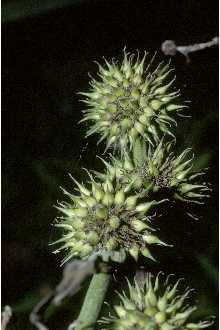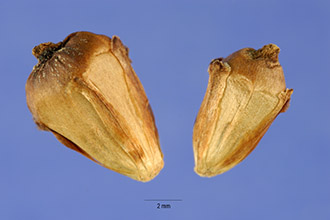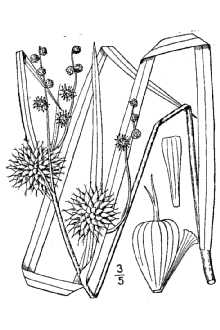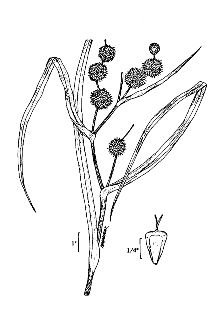Sparganium californicum Greene
Scientific Name: Sparganium californicum Greene

| General Information | |
|---|---|
| Usda Symbol | SPCA14 |
| Group | Monocot |
| Life Cycle | Perennial |
| Growth Habits | Forb/herb |
| Native Locations | SPCA14 |
Plant Guide
Uses
Ethnobotanic..The Klamath Indians dug the tubers (possibly Sparganium angustifolium, S. erectum, and/or S. eurycarpum) produced in late autumn from the creeping rootstocks of some of the species of this genus, and use them as food (Steyermark 1963). An infusion of Sparanium erectum can be mixed with other plant leaves and used in the treatment of chills (Moerman 1998). A decoction of Sparganium stoloniferum root was used in the treatment of chest pains and abdominal pain (Yeung 1985).
Status
Please consult the PLANTS Web site and your State Department of Natural Resources for this plant’s current status, such as, state noxious status and wetland indicator values.
Description
General: Bur-reed family (Sparaniaceae). American bur-reed Sparganium americanum (SPAM) Robert Mohlenbrock USDA, NRCS, Wetland Sciences Institute @ PLANTS branched bur-reed Sparganium androcladum (SPAN) narrowleaf bur-reed Sparganium angustifolium (SPAN2) simplestem bur-reed Sparganium erectum (SPER) broadfruit bur-reed Sparganium eurycarpum (SPEU) floating bur-reed Sparganium fluctuans (SPFL) clustered bur-reed Sparganium glomeratum (SPGL) northern bur-reed Sparganium hyperboreum (SPHY) small bur-reed Sparganium natans (SPNA) These bur-reed species are native, herbaceous marsh or pond plants with rootstocks. The leaves are alternate, stiff and erect or limp and floating, linear, and internally septate (The Great Plains Flora Association 1986). The individual flowers are small and occur in separate male (staminate) or female (pistillate) globular clusters on the same plant. (Steyermark 1963). Distribution: A genus of twenty or more Sparanium species is widely distributed in temperate and colder latitudes of the eastern and western hemispheres, and in eastern North America (Braun 1967). For current distribution, please consult the Plant profile page for this species on the PLANTS Web site.
Adaptation
This species grows best on wet ground in rich soil. It prefers full sun but can tolerate some shade. Sparanium species is mostly found in muddy or shallow water of swamps and ponds. For current distribution, please consult the Plant profile page for this species on the PLANTS Web site
Establishment
Propagation by Seed: Sparanium seeds should be sown as soon as they are ripe in the greenhouse, This species should be placed in pots standing in two to three centimeters of water, Place the seedlings into individual pots when they are large enough to handle and gradually increase the depth of water with plant growth, Use soil moisture sensors to measure the soil moisture of Sparganium californicum Greene., Plant Sparanium sp to their permanent positions in the summer, Large divisions can be planted directly into their permanent positions, While allowing smaller potted divisions to grow in a cold frame until they are well established and ready for summer out-planting to their permanent location,,
Management
Seeds of most aquatic plants should be sown as soon as they are ripe. The seeds lose viability quickly if it is allowed to dry out. If immediate sowing is inconvenient, store seeds in moist peat, or substitute in a plastic bag and keep frost-free (Heuser 1997). Cultivars, Improved and Selected Materials (and area of origin) Contact your local Natural Resources
Conservation
Service (formerly Soil Conservation Service) office for more information. Look in the phone book under ”United States Government.” The Natural Resources Conservation Service will be listed under the subheading “Department of Agriculture.”
References
Braun, L.E. 1967. The monocotyledoneae from cat-tails to orchids. The Ohio State University Press, Columbus, Ohio. Gleason, H. A. & A. Cronquist 1993. Manual of vascular plants of northeastern United States and adjacent Canada. 2nd ed. The New York Botanical Garden, Bronx, New York. Heuser, C. W. 1997. The complete book of plant propagation. The Taunton Press, Newtown, Connecticut. Peck, M.E. 1961. A manual of the higher plants of Oregon. 2nd ed. Oregon State University Press, Portland, Oregon. Small, J.K. 1933. Manual of the southeastern flora. The University of North Carolina Press, Chapel Hill, North Carolina. Steyermark, J. A. 1963. Flora of Missouri. The Iowa State University Press, Ames, Iowa. Strausbaugh, P. D. & E. L. Core 1977. Flora of West Virginia. 2nd ed. Seneca Books, Inc., Morgantown, West Virginia. The Great Plains Flora Association 1986. Flora of the Great Plains. University Press of Kansas, Lawrence, Kansas. Yeung, H.C. 1985. Handbook of Chinese herbs and formulas. Institute of Chinese Medicine, Los Angeles, California.
Plant Traits
Growth Requirements
| Temperature, Minimum (°F) | -33 |
|---|---|
| Adapted to Coarse Textured Soils | Yes |
| Adapted to Fine Textured Soils | Yes |
| Adapted to Medium Textured Soils | Yes |
| Anaerobic Tolerance | High |
| CaCO3 Tolerance | Medium |
| Cold Stratification Required | No |
| Drought Tolerance | None |
| Fertility Requirement | Low |
| Fire Tolerance | None |
| Frost Free Days, Minimum | 95 |
| Hedge Tolerance | None |
| Moisture Use | High |
| pH, Maximum | 8.5 |
| pH, Minimum | 5.0 |
| Planting Density per Acre, Maxim | 4800 |
| Planting Density per Acre, Minim | 3500 |
| Precipitation, Maximum | 50 |
| Precipitation, Minimum | 10 |
| Root Depth, Minimum (inches) | 12 |
| Salinity Tolerance | None |
| Shade Tolerance | Intermediate |
Morphology/Physiology
| After Harvest Regrowth Rate | Slow |
|---|---|
| Toxicity | None |
| Resprout Ability | No |
| Shape and Orientation | Erect |
| Active Growth Period | Spring |
| Bloat | None |
| Coppice Potential | No |
| Fall Conspicuous | No |
| Fire Resistant | No |
| Flower Color | Green |
| Flower Conspicuous | No |
| Foliage Color | Green |
| Foliage Porosity Summer | Moderate |
| Foliage Porosity Winter | Porous |
| Fruit/Seed Color | Green |
| Nitrogen Fixation | None |
| Low Growing Grass | No |
| Lifespan | Moderate |
| Leaf Retention | No |
| Known Allelopath | No |
| Height, Mature (feet) | 4.9 |
| Growth Rate | Moderate |
| Growth Form | Colonizing |
| Fruit/Seed Conspicuous | No |
| Foliage Texture | Medium |
Reproduction
| Vegetative Spread Rate | Rapid |
|---|---|
| Small Grain | No |
| Seedling Vigor | High |
| Seed Spread Rate | Moderate |
| Fruit/Seed Period End | Fall |
| Seed per Pound | 1468 |
| Propagated by Tubers | No |
| Propagated by Sprigs | Yes |
| Propagated by Sod | No |
| Propagated by Seed | Yes |
| Propagated by Corm | No |
| Propagated by Container | No |
| Propagated by Bulb | No |
| Propagated by Bare Root | No |
| Fruit/Seed Persistence | Yes |
| Fruit/Seed Period Begin | Spring |
| Fruit/Seed Abundance | Medium |
| Commercial Availability | Routinely Available |
| Bloom Period | Indeterminate |
| Propagated by Cuttings | No |
Suitability/Use
| Veneer Product | No |
|---|---|
| Pulpwood Product | No |
| Post Product | No |
| Palatable Human | No |
| Palatable Browse Animal | Medium |
| Nursery Stock Product | No |
| Naval Store Product | No |
| Lumber Product | No |
| Fodder Product | No |
| Christmas Tree Product | No |
| Berry/Nut/Seed Product | No |



